It has been seven years since Portsmouth and Southampton faced each other in the South Coast derby. During that period, both teams have played other rivals in Bournemouth and Brighton, but the atmosphere just didn’t feel the same. However, the draw for the EFL Cup’s third round has drawn these two clubs together in a match that took place at Portsmouth’s Fratton Park.
After missing out on promotion last season, the home side were determined to make things different this time. But a struggling start with only one win and three draws in their first seven games in League One caused some minor concerns among the fans. Still, they hoped to secure a win over their fierce rival and used it as momentum for bigger things this season.
For Southampton, they were improving themselves day by day under Ralph Hasenhüttl. He employed a fast-paced, attractive style of play and also put an emphasis on high pressing and quick turnovers. Amid the slow start to the Premier League season, they brought high confidence into the derby. And they demonstrated perfectly through a 4-0 dominant win thanks to Danny Ings’ brace and two goals from Cédric Soares and Nathan Redmond.
This tactical analysis will provide an analysis of Southampton’s dominant win over Portsmouth in the EFL Cup this season. Meanwhile, using statistics, we will point out what went wrong in Kenny Jackett’s tactics over Ralph Hasenhüttl’s tactics.
Lineups
Portsmouth lined up in a 4-2-3-1 formation with Craig MacGillivray retaining his spot as the team’s number one. Striker Oli Hawkins was converted back into a centre-back again after he delivered a decent performance against Wycombe alongside Christian Burgess. It was thought that captain Tom Naylor might be absent from this match after sustaining two knocks in the same match, but he was fit to return and paired up with Ben Close in front of Portsmouth’s defence.
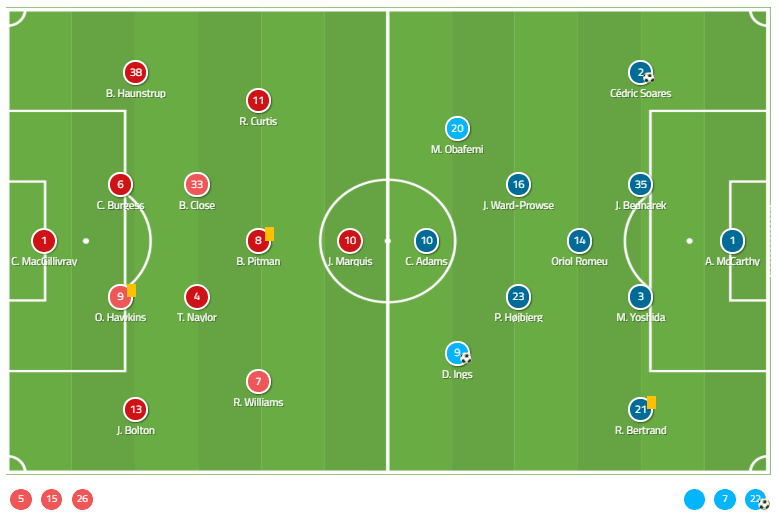
Hasenhüttl made a slight change to the team’s formation as he went for a 4-1-2-3. The Malian winger Moussa Djenepo was certain to miss out through injury he had suffered earlier. After starting for Southampton in the 3-1 loss against Bournemouth, both Sofiane Boufal and Nathan Redmond appeared on the bench as they were replaced by Danny Ings and Michael Obafemi.
Goalkeeper Alex McCarthy came into the lineup to fill in the place that Angus Gunn left behind. The Austrian manager also shifted a couple of positions in his back four with Maya Yoshida and Ryan Bertrand returned to the side.
Southampton’s style of play
As mentioned, Hasenhüttl encouraged his players to press aggressively and attempt to recover possession whenever possible. Using a 4-1-2-3 formation that positioned fairly high, the visitors were able to execute their plan. In case Portsmouth used goal kicks to aim the ball towards their attackers, the players would regroup into the shape and swarm the middle third.
Firstly, both the wingers Ings and Obafemi dropped deep to join up with the midfielders. At times they could change the formation into a 4-2-3-1 with James Ward-Prowse moving in between them. They used this strategy quite often when they pushed up and pressed the opponent inside their half as it allowed them to match Portsmouth’s numbers.
Meanwhile, Oriol Romeu and Pierre-Emile Højbjerg had the tendency of sticking to their formation and screened the space in front of the defensive line. Since the former was a defensive-minded player, he dropped even deeper than his colleague to narrow the space between the line. But the Spanish midfielder could also be aggressive in joining the press and won possession back. In total, Romeu was involved in nine defensive duels and registered ten recoveries inside Southampton’s half- a decent number for a consistent performer throughout the match.
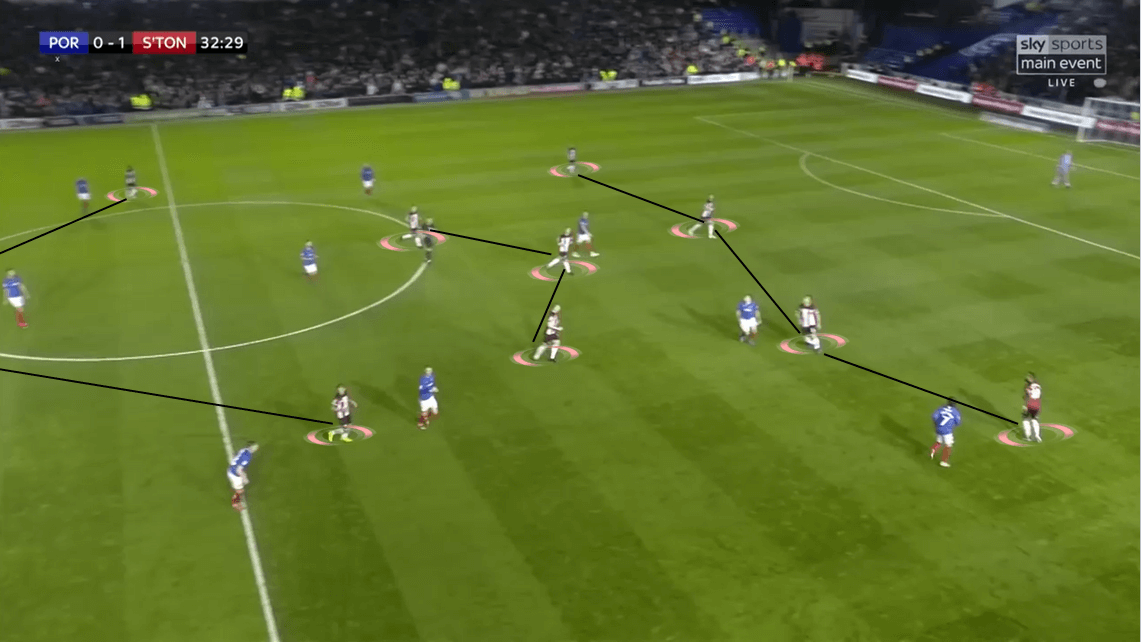
To engage the press, the players would create an overload to surround the ball carrier and at the same time, marked every possible passing option. This required the flexible movement from the midfield three as they had to shift laterally and acted as the shield around the ball carrier.
Romeu and Højbjerg were the most active players during the team’s press as they usually approached the ball carrier and tackled the ball. Meanwhile the nearest centre-back and wing-back, in this situation as shown below it was Yoshida and Bertrand, provided support through capitalising on heavy touches and even actively tackled the ball. With at least four players involved in the press, they had numerical superiority to recover possession and eliminated the potential receivers that the ball carrier had.
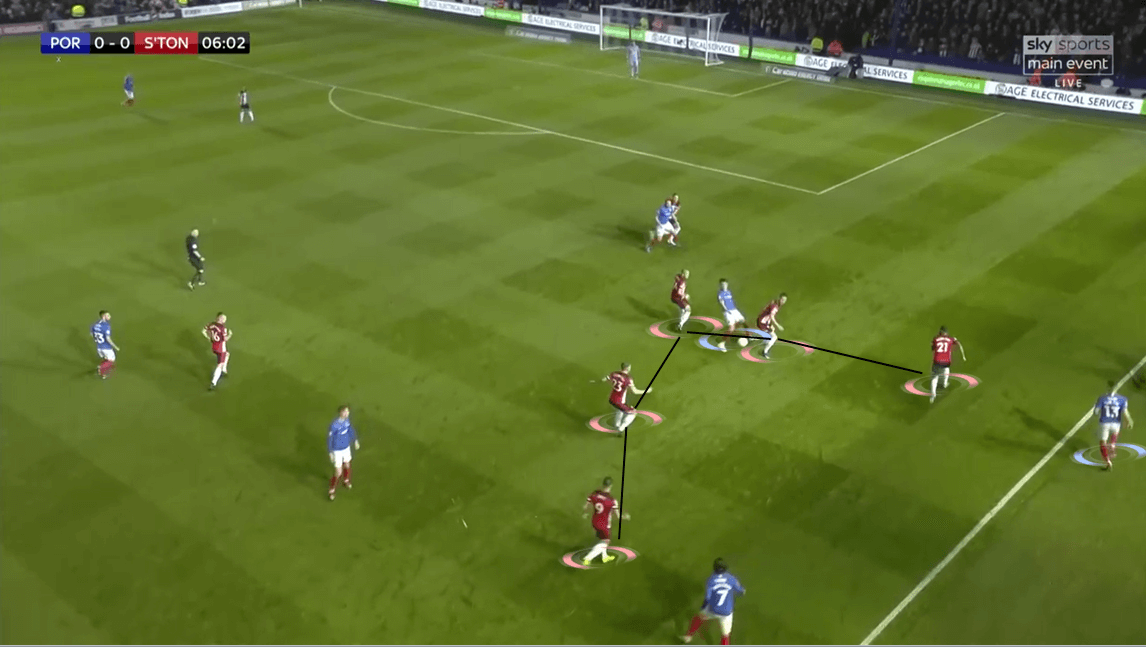
High up the pitch, they also adapted the similar principles along with the man-oriented press in which the attackers were responsible for marking Portsmouth’s defenders. Meanwhile, two central midfielders followed Close and Naylor and prevented them from coming shortly for a passing option.
Their pressing shape also shifted flexibly with the ball and left the farthest winger free. This allowed them to create a pressing overload and won the ball back more efficiently. They didn’t also worry about being superior in numbers when Portsmouth’s wide midfielders dropped deep. Since both wing-backs had followed them, they could match them and continue the press.
When in possession, they focused on building their attacks from the backline. Again, we can see the involvement of both Romeu and Højbjerg in the shot below. Combined with two centre-backs, they created a passing block which was positioned inside the middle third. With them coming deep, Southampton could create more passing triangles for their ball circulating process and deal with the pressure from Portsmouth.
It also allowed both wing-backs, Cédric and Bertrand, to move high up the pitch and join the attack. They would locate themselves on the edge of the final third and turn themselves into a possible attacking option out wide using their pace.
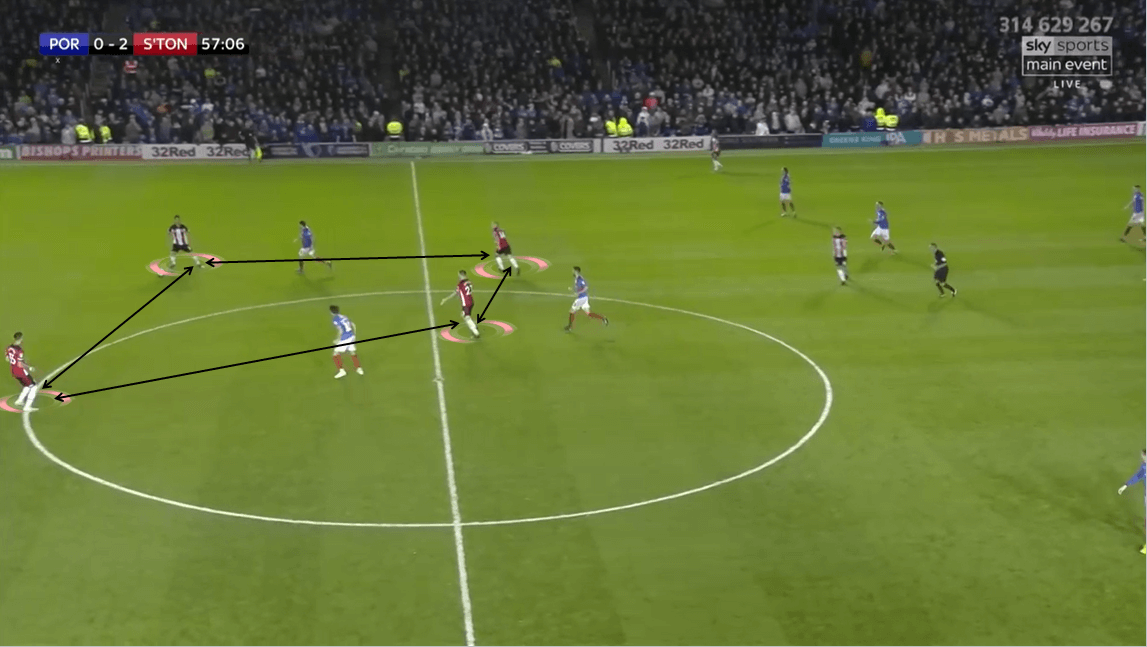
We can also see Southampton’s build-up intention through their passing map in this game. Indeed, it does not come as a surprise to see the top five links all come from the four players involved in the build-up process, with Yoshida and Højbjerg topping the list.
It’s also worth noting Ward-Prowse’s role in this game: playing as a dynamic midfielder who divided his attacking and defending responsibility equally, he would capitalise on pockets of space that Portsmouth players left behind. Using his flexible movement, he could shift in between the opposition’s lines and cause confusion for their defenders.
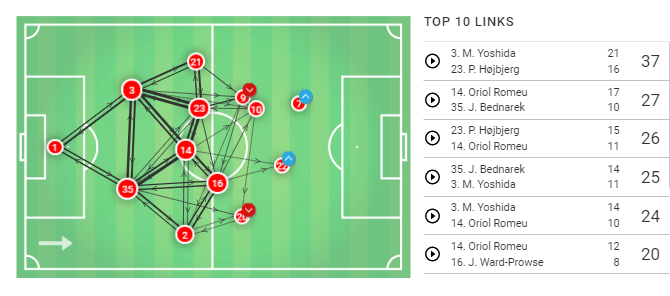
Their flexibility in the attack was not only shown through Ward-Prowse’s positioning and movements, but through both Ings and Obafemi as well. While the Irish striker tended to drift into the half-space to create space for Cédric, Ings would rather stay close to Ché Adams.
This season, they have formed a close-knit relationship when Hasenhüttl chose them to lead the line in his 4-2-2-2 formation. And with two different styles of play, they were able to capitalise one’s advantages and make up for the other’s disadvantages. In the match, Adams occasionally dropped deep from his position to pick up the ball. He also roamed more from his position and located himself between Portsmouth’s defensive line.
Meanwhile, playing slightly to the left of his preferred position, Ings cut inside more and capitalised on the space behind the defensive line. In one of the situations where these two linked up with each other, as shown below, the former Birmingham City striker came short to receive the ball and made a dink toward the space behind Hawkins and Brandon Haunstrup. From his position, Ings made a run into that gap to turn up at the end of the pass. There, he used his pace to sprint towards the box and involved in a 1 v 1 situation with MacGillivray, only to be beaten by the former Walsall goalkeeper.
Their partnership is looked to be quite similar to how Hasenhüttl used Timo Werner and Yussuf Poulsen during his time at RB Leipzig. Both of those players have the pace to beat their markers, with the latter being superior in physicality to act as a target man, and so too is Ings and Adams respectively for the Saints. With that being said, it doesn’t mean that they were and are playing in the same role as Werner and Poulsen, since they all have different styles of play, but still receive similar instructions.
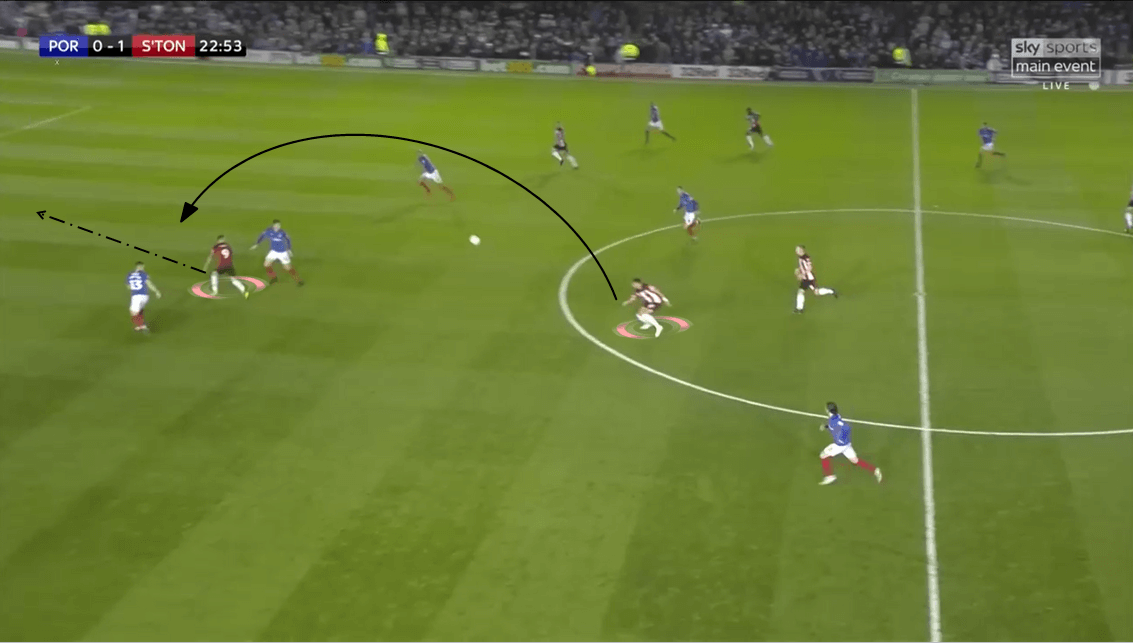
Throughout the match and this analysis, we have talked about how Southampton capitalised on the gaps that Portsmouth constantly created in the match, and eventually the visitors did convert them into goals. In the shot below, notice how the home side left a big gap in the central circle although surrounding that area were four players.
From the build-up, Jan Bednarek noticed the gap and Nathan Redmond’s intention of moving into that area. He picked out the former Norwich player with a through pass and allowed him to continue his run. Burgess immediately closed him down but his effort was only enough to push the ball behind substitute Paul Downing. Redmond still ran towards the ball when Portsmouth defenders called for an offside. Since their call wasn’t accepted, some of their players were caught in their positions and allowed Redmond to get his name on the scoresheet.
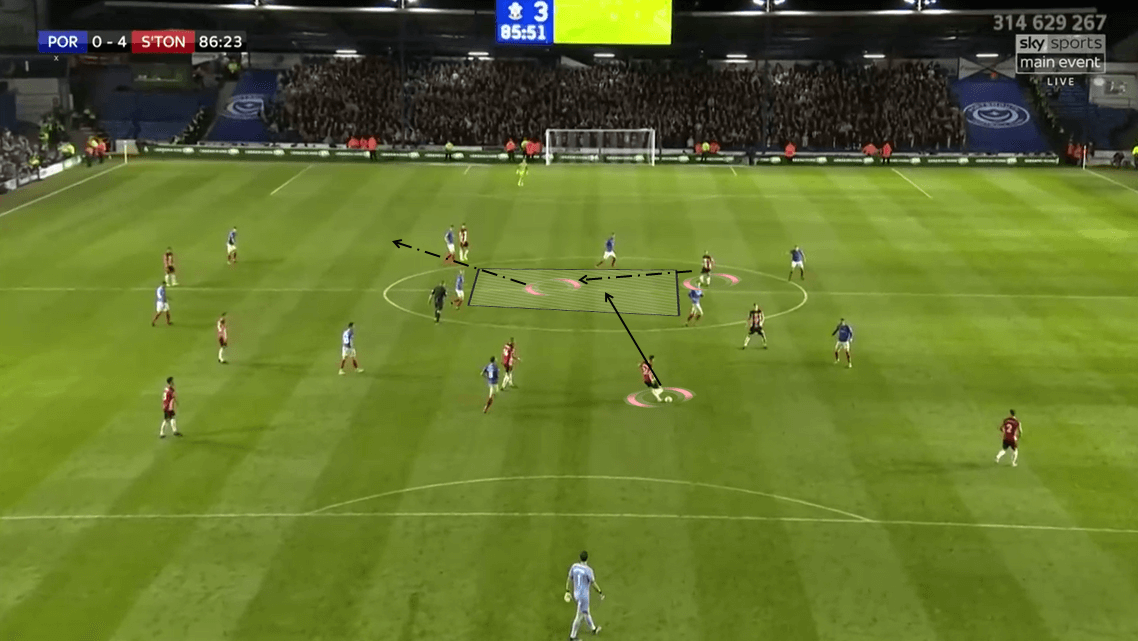
They also had another situation inside the first half which led to Ings’ opening goal of the game. Earlier, he had his first attempt saved by MacGillivray but there were no Portsmouth player to pick up the ball. This allowed Ward-Prowse to close in, reach for the ball and restart their attack.
As he turned himself towards Portsmouth’s goal, he noticed Ings, who positioned himself on the edge of the 16-yard box. Surprisingly, although Portsmouth had seven players inside the box, they left the former Burnley striker to receive the ball in a free state. He punished their error with a sharp turn and a decisive finish into the bottom right corner.
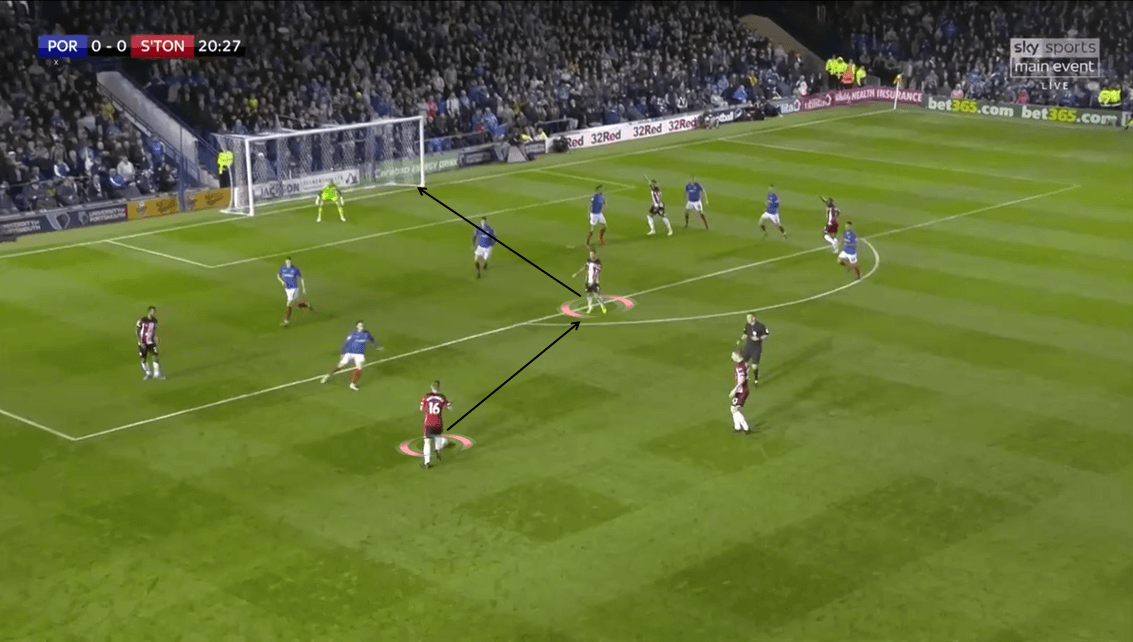
Portsmouth’s style of play
No matter if you are an underdog or not, it is important to give your fans a good shout in one of the most important matches of the season. But that didn’t seem to be the case for Portsmouth in this match- they didn’t have such a good day in front of goal, as they only turned three of their fourteen shots on target.
But in contrast to that, they had six chances that were decently rated in xG, specifically higher than 0.1. Furthermore, with most of their chances coming inside or on the edge of the box, they should have at least secured a consolation goal. Unfortunately, luck wasn’t on their side on the day that they aimed to send their fans home with a smile on their faces.
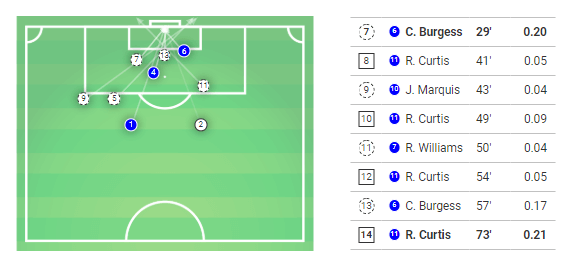
To understand why they struggled to put the ball into the net, it’s worth looking at how they created their attacks. Since Portsmouth were a wing-oriented team, the players usually looked to distribute the ball wide. In Ryan Williams and Ronan Curtis, they had two pacey wingers who looked to work more both inside the half-spaces and the wide area.
They would combine with wing-backs Haunstrup and James Bolton to make the most out of both flanks. Whenever the wing-back intended to make an overlap, either Williams or Curtis moved into the half-space and dragged along Southampton defenders. This created a pocket of space out wide while allowing them to dribble with the ball and send crosses into the box.
On several occasions, they stuck to their position and attempted to stretch Southampton’s defensive line. Also, by utilising the space behind Cédric and Bertrand when these two moved up and joined the press, they could receive a long ball from the central midfielders. It allowed Portsmouth to attack with at least three players, two wingers and striker John Marquis and win numerical superiority during their attacking transitions.
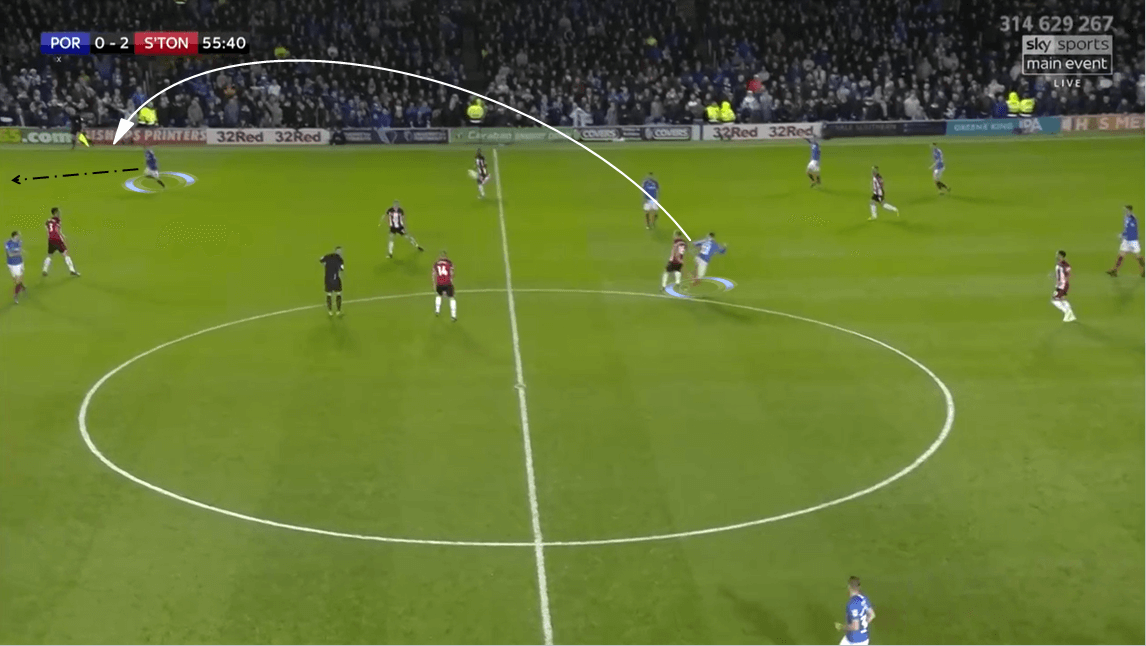
Defensively, they employed the strategy of pressing high up the pitch. But the players didn’t tend to apply pressure on Southampton’s defenders heavily, aggressively and constantly. Instead, keeping a sufficient distance from the ball carrier and the possible passing options was their choice instead.
Using a man-oriented press, they were able to keep each of the opposition’s defenders in sight and knew when they needed to approach them. On the other hand, since they opted to stay conservative in their press, Southampton had a fair few chances to bypass it and progressed the ball up the pitch.
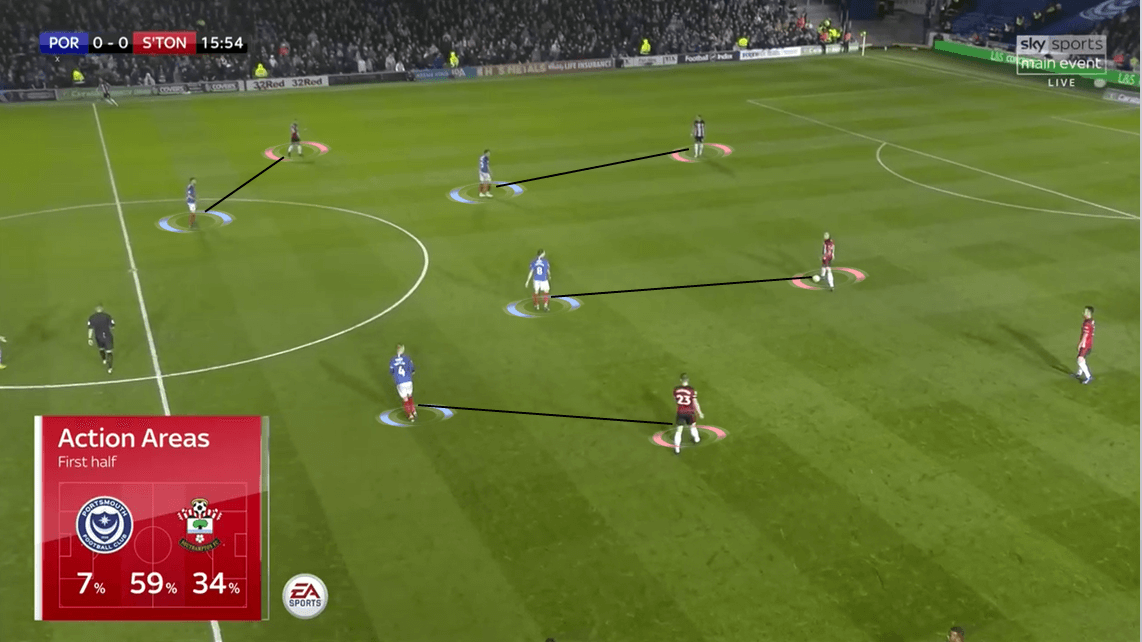
In that case, the players would retreat into a 4-4-1-1 defensive shape, at times could look like a 4-4-2 when Brett Pitman joined Marquis to form the first line of engagement. They stayed close to each other and attempted to swarm a certain side during Southampton’s build-up. It prevented them from making passes into that flank and they were left no choice but to make a back pass.
As usual, both strikers would be the first players to start the press as they followed Southampton’s centre-backs. Meanwhile, they also positioned themselves in between the passing block to eliminate Romeu and Højbjerg from turning themselves into potential receivers. The two central midfielders were also being controlled by Close and Naylor due to their positioning.
To deal with the fact that either Bednarek and Yoshida might make long passes into space behind their defensive line, the defenders were instructed to stay on the edge of their defensive third. Although this could leave a gap between the lines and invited Southampton attackers to move in, they accepted that risk while knowing Close and Naylor could also occupy that area.
Still, as mentioned, when they managed to close one gap, the other one was opened. The likes of Adams, Ings and Obafemi had many chances to pick up the ball after they moved in those gaps and it resulted in dangerous attacks for Southampton. Eventually, the away side penalised them through most of their goals, especially from Ings’ brace.
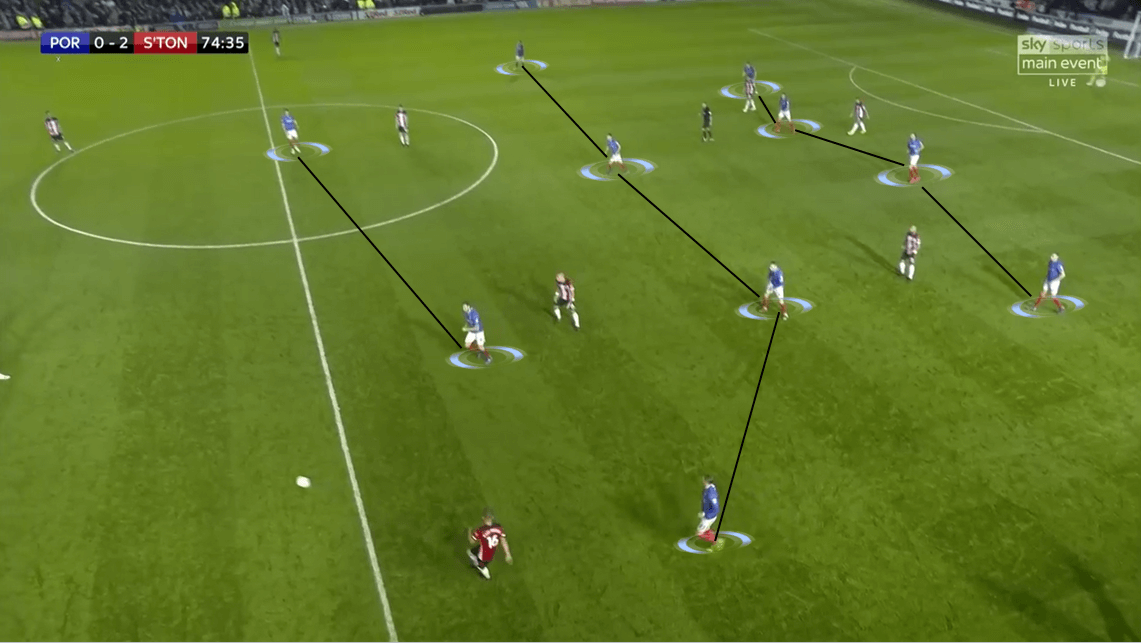
Conclusion
After a long seven-year period of endless waiting for a South Coast derby, Portsmouth and Southampton finally met each other. And they have provided us with a very fascinating match from the tactical perspective. It’s no surprise to see the intention of aiming for a win from both sides, but in football, there could only be one. Southampton had come out on top through four goals being spread in both halves and at times showed signs of domination. It will be big momentum for Hasenhüttl and his players as this can build their confidence for their match against Tottenham this weekend.
Portsmouth, on the other hand, surely couldn’t accept a defeat against their rival. In a match that you don’t have the occasion to see and play so often, it’s important to create good memories about it, which wasn’t the case for the home side. Nonetheless, they have to learn from what caused this defeat and find a solution to fix it when they later welcome Bolton Wanderers to their home ground this Saturday.

If you love tactical analysis, then you’ll love the digital magazines from totalfootballanalysis.com – a guaranteed 100+ pages of pure tactical analysis covering topics from the Premier League, Serie A, La Liga, Bundesliga and many, many more. Buy your copy of the September issue for just ₤4.99 here




Comments